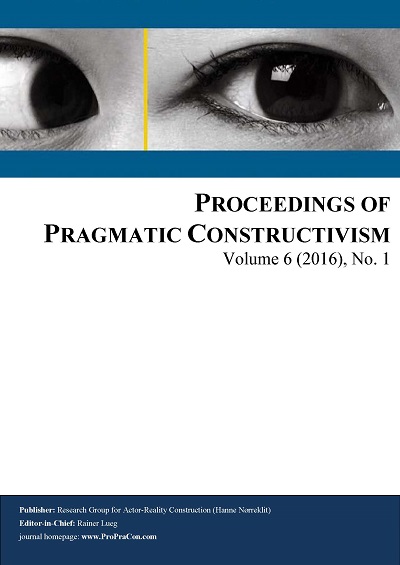The illusion of New Public Management? An analysis of performance-based budgeting in the public sector
DOI:
https://doi.org/10.7146/propracon.v6i1.25144Keywords:
New Public Management, Performance Based Budgeting, reality vs illusion in pragmatic constructivismAbstract
The present research wishes to adopt a pragmatic constructivist approach in order to understand and explain the functionality of private- inspired reforms in the public sector. In particular, the research investigates the introduction and implementation of a relevant but challenging managerial reform, performance- based budgeting (PBB), become widespread in the public sector worldwide.References
Bogt, H. J., Helden, G. J., & Kolk, B. (2015). Challenging the NPM Ideas About Performance Management: Selectivity and Differentiation in Outcome‐Oriented Performance Budgeting. Financial Accountability & Management, 31(3), 287-315.
Cinquini, L., Tenucci, A., Campanale, C., Passetti, E. (2013). Understanding performance measurement in public organization under pragmatic constructivism. The Actor Reality Perspective Conference.
Dobel, J. P. (1978). The corruption of a state. American Political Science Review, 72(03), 958-973.
Hood, C. (1991). A public management for all seasons?. Public administration, 69(1), 3-19.
Hood, C. (1995). The “New Public Management” in the 1980s: variations on a theme. Accounting, organizations and society, 20(2), 93-109.
Hoskin, K. (2015). What about the box?” Some thoughts on the possibility of ‘corruption prevention’, and of ‘the disciplined and ethical subject. Critical Perspectives on Accounting, 28, 71-81.
Hyndman, N., Liguori, M., Meyer, R. E., Polzer, T., Rota, S., & Seiwald, J. (2014). The translation and sedimentation of accounting reforms. A comparison of the UK, Austrian and Italian experiences. Critical Perspectives on Accounting, 25(4), 388-408.
Johnston, M. (2015). Making transparency real? Accounting and popular participation in corruption control. Critical Perspectives on Accounting, 28, 97-101.
Lapsley, I. (2008). The NPM agenda: back to the future. Financial accountability & management, 24(1), 77-96.
Lehman, G. (2010). Perspectives on accounting, commonalities & the public sphere. Critical Perspectives on Accounting, 21(8), 724-738.
Lynn Jr, L. E. (1998). The new public management: How to transform a theme into a legacy. Public Administration Review, 231-237.
Mitchell, F., Nielsen, L. B., Nørreklit, H., & Nørreklit, L. (2013). Scoring strategic performance: a pragmatic constructivist approach to strategic performance measurement. Journal of Management & Governance, 17(1), 5-34.
Morales, J., Gendron, Y., & Guénin-Paracini, H. (2014). The construction of the risky individual and vigilant organization: A genealogy of the fraud triangle. Accounting, Organizations and Society, 39(3), 170-194.
Nørreklit, L. (2011), “Actors and reality: a conceptual framework for creative governance”, in Jakobsen, M., Johansson, I.-L. and Nørreklit, H. (Eds.), An Actor's Approach to Management Conceptual Framework and Company Practices, Djøf/Jurist- og Økonomforbundet, pp. 7-38.
Nørreklit, L., Nørreklit, H., & Israelsen, P. (2006). The validity of management control topoi: towards constructivist pragmatism. Management Accounting Research, 17(1), 42-71.
OECD (2007). Performance budgeting in OECD Countries. OECD Publishing.
Robinson, M. (2007). Performance Budgeting: Linking Funding and Results. International Monetary Fund.
Stiglitz, J. E. (1989). The economic role of the state.
Yin, R. (1994). Case study research: Design and methods. Beverly Hills.
Downloads
Published
How to Cite
Issue
Section
License
Previous and future use of the work
ProPraCon assumes the non-exclusive rights to publish and store the work of its authors, once they have consented to a publication. Since the rights to publish are non-exclusive, authors are free to re-use their work, e.g., to publish it in other media (as ProPraCon aims at publishing proceedings). Hence, it is explicitly allowed that works submitted to ProPraCon may be published in a somehow similar form in other media. Yet, submitting authors warrant that the work is not an infringement of any existing copyright and will indemnify the publisher against any breach of such warranty.
Permissions
By submitting work to ProPraCon, the authors declare that they have permission to use any content that has not been created by them. Specifically, when using tables, figures or excerpts of more than 400 words, it is expected that the authors…
- …obtain written permission of copyright for the use in print and electronic formats of any of their text, illustrations, graphics, or other material, in their work. This includes any minor adaptations.
- …acknowledge the original source in captions and in the reference list.





